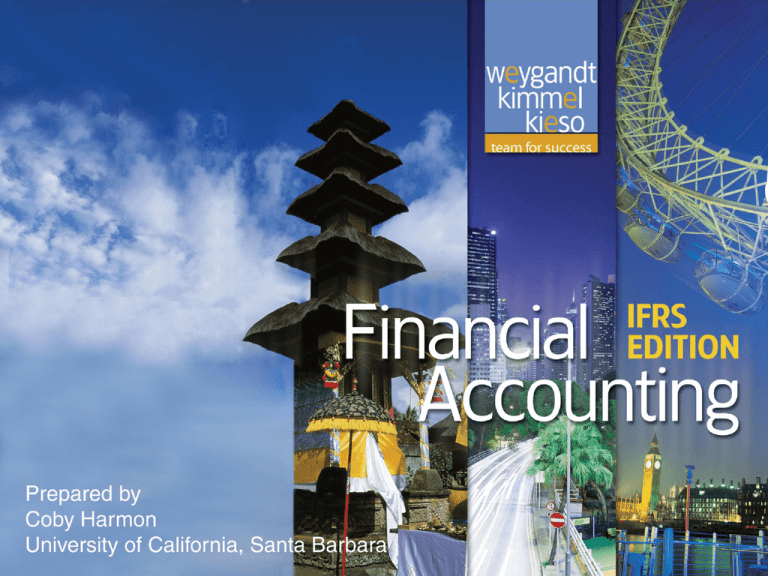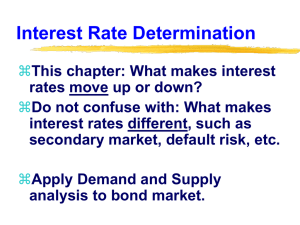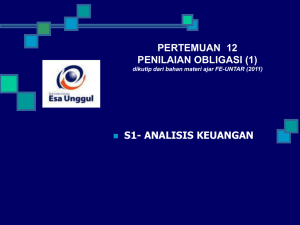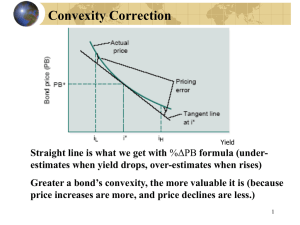
Slide
10-1
Chapter
10
Liabilities
Financial Accounting, IFRS Edition
Weygandt Kimmel Kieso
Slide
10-2
Study Objectives
Slide
10-3
1.
Explain a current liability, and identify the major types of current
liabilities.
2.
Describe the accounting for notes payable.
3.
Explain the accounting for other current liabilities.
4.
Explain why bonds are issued, and identify the types of bonds.
5.
Prepare the entries for the issuance of bonds and interest
expense.
6.
Describe the entries when bonds are redeemed.
7.
Describe the accounting for long-term notes payable.
8.
Identify the methods for the presentation and analysis of noncurrent liabilities.
Liabilities
Current Liabilities
Notes payable
Bond basics
Sales taxes payable
Accounting for bond issues
Unearned revenues
Accounting for bond
retirements
Current maturities of longterm debt
Statement presentation
and analysis
Slide
10-4
Non-Current Liabilities
Accounting for long-term
notes payable
Statement presentation and
analysis
Section 1 Current Liabilities
What is a Current Liability?
Current liability is debt with two key features:
1. Company expects to pay the debt from existing
current assets or through the creation of other current
liabilities.
2. Company will pay the debt within one year or the
operating cycle, whichever is longer.
Current liabilities include notes payable, accounts payable, unearned
revenues, and accrued liabilities such as taxes payable, salaries payable,
and interest payable.
Slide
10-5
SO 1 Explain a current liability, and identify the
major types of current liabilities.
What is a Current Liability?
Question
To be classified as a current liability, a debt must be
expected to be paid:
a. out of existing current assets.
b. by creating other current liabilities.
c. within 2 years.
d. both (a) and (b).
Slide
10-6
SO 1 Explain a current liability, and identify the
major types of current liabilities.
What is a Current Liability?
Notes Payable
Written promissory note.
Require the borrower to pay interest.
Issued for varying periods.
Slide
10-7
SO 2 Describe the accounting for notes payable.
What is a Current Liability?
Illustration: On March 1, 2011, Cole Williams borrows
$100,000 from First National Bank on a 4-month, 12% note.
Instructions
a) Prepare the entry on March 1.
b) Prepare the adjusting entry on June 30, assuming
monthly adjusting entries have not been made.
c) Prepare the entry at maturity (July 1).
Slide
10-8
SO 2 Describe the accounting for notes payable.
What is a Current Liability?
Illustration: On March 1, 2011, Cole Williams borrows
$100,000 from First National Bank on a 4-month, 12% note.
a) Prepare the entry on March 1.
Cash
100,000
Notes payable
100,000
b) Prepare the adjusting entry on June 30.
$100,000 x 12% x 4/12 = $4,000
Interest expense
Interest payable
Slide
10-9
4,000
4,000
SO 2 Describe the accounting for notes payable.
What is a Current Liability?
Illustration: On March 1, 2011, Cole Williams borrows
$100,000 from First National Bank on a 4-month, 12% note.
c) Prepare the entry at maturity (July 1).
Notes payable
Interest payable
Cash
Slide
10-10
100,000
4,000
104,000
SO 2 Describe the accounting for notes payable.
What is a Current Liability?
Sales Tax Payable
Sales taxes are expressed as a stated percentage of
the sales price.
Either rung up separately or included in total receipts.
Retailer collects tax from the customer.
Retailer remits the collections to the state’s
department of revenue.
Slide
10-11
SO 3 Explain the accounting for other current liabilities.
What is a Current Liability?
Illustration: The March 25 cash register reading for Cooley
Grocery shows sales of $10,000 and sales taxes of $600 (sales
tax rate of 6%), the journal entry is:
Cash
10,600
Sales
10,000
Sales tax payable
Slide
10-12
600
SO 3 Explain the accounting for other current liabilities.
What is a Current Liability?
Unearned Revenue
Revenues that are received before the company delivers
goods or provides services.
1. Company debits Cash, and credits
a current liability
account (unearned revenue).
2. When the company earns the
revenue, it debits the
Unearned Revenue account, and
credits a revenue account.
Slide
10-13
SO 3 Explain the accounting for other current liabilities.
What is a Current Liability?
Illustration: Assume that Superior University sells 10,000
season football tickets at $50 each for its five-game home
schedule. The university makes the following entry for the sale
of season tickets:
Aug. 6
Cash
Unearned revenue
500,000
500,000
As the school completes each of the five home games, it would
record the revenue earned.
Sept. 7
Slide
10-14
Unearned revenue
Ticket revenue
100,000
100,000
SO 3 Explain the accounting for other current liabilities.
What is a Current Liability?
Unearned Revenue
Slide
10-15
Illustration 10-2
Unearned and earned
revenue accounts
SO 3 Explain the accounting for other current liabilities.
What is a Current Liability?
Current Maturities of Long-Term Debt
Portion of long-term debt that comes due in the
current year.
No adjusting entry required.
Slide
10-16
SO 3 Explain the accounting for other current liabilities.
Statement Presentation and Analysis
Presentation
Slide
10-17
Illustration 10-3
Statement of financial position presentation
of current liabilities (in thousands)
SO 3 Explain the accounting for other current liabilities.
Statement Presentation and Analysis
Analysis
Illustration 10-4
The current ratio permits
us to compare the liquidity
of different-sized
companies and of a single
company at different
times.
Slide
10-18
Liquidity refers to the
ability to pay maturing
obligations and meet
unexpected needs for
cash.
Illustration 10-5
SO 3 Explain the accounting for other current liabilities.
Statement Presentation and Analysis
Question
Working capital is calculated as:
a. current assets minus current liabilities.
b. total assets minus total liabilities.
c. non-current liabilities minus current liabilities.
d. both (b) and (c).
Slide
10-19
SO 3 Explain the accounting for other current liabilities.
Section 2 Non-Current Liabilities
Bond Basics
Bonds are a form of interest-bearing notes payable.
Three advantages over ordinary shares:
1. Stockholder control is not affected.
2. Tax savings result.
3. Earnings per share may be higher.
Slide
10-20
SO 4 Explain why bonds are issued, and identify the types of bonds.
Bond Basics
Effects on earnings per share—equity vs. debt.
Illustration 10-7
Slide
10-21
SO 4 Explain why bonds are issued, and identify the types of bonds.
Bond Basics
Question
The major disadvantages resulting from the use of bonds
are:
a. that interest is not tax deductible and the principal
must be repaid.
b. that the principal is tax deductible and interest must
be paid.
c. that neither interest nor principal is tax deductible.
d. that interest must be paid and principal repaid.
Slide
10-22
SO 4 Explain why bonds are issued, and identify the types of bonds.
Bond Basics
Types of Bonds
Secured and Unsecured (debenture) bonds.
Term and Serial bonds.
Registered and Bearer (or coupon) bonds.
Convertible and Callable bonds.
Slide
10-23
SO 4 Explain why bonds are issued, and identify the types of bonds.
Bond Basics
Issuing Procedures
Bond contract known as a bond indenture.
Represents a promise to pay:
(1) sum of money at designated maturity date, plus
(2) periodic interest at a contractual (stated) rate on the
maturity amount (face value).
Paper certificate, typically a $1,000 face value.
Interest payments usually made semiannually.
Generally issued when the amount of capital needed is too
large for one lender to supply.
Slide
10-24
SO 4 Explain why bonds are issued, and identify the types of bonds.
Bond Basics
Issuer of
Bonds
Illustration 10-8
Maturity
Date
2013
DUE 2013
DUE 2013
Contractual
Interest
Rate
Slide
10-25
Face or
Par Value
SO 4
Bond Basics
Bond Trading
Bonds traded on national securities exchanges.
Newspapers and the financial press publish bond prices and
trading activity daily.
Read as: Outstanding 5.125%, $1,000 bonds that mature in 2014.
Currently yield a 5.747% return. On this day, $33,965,000 of these
bonds were traded. Closing price was 96.595% of face value, or
$965.95.
Slide
10-26
SO 4 Explain why bonds are issued, and identify the types of bonds.
Bond Basics
Determining the Market Value of Bonds
Market value is a function of the three factors that determine
present value:
1. dollar amounts to be received,
2. length of time until the amounts are received, and
3. market rate of interest.
The features of a bond (callable, convertible, and so on) affect the
market rate of the bond.
Slide
10-27
SO 4 Explain why bonds are issued, and identify the types of bonds.
Slide
10-28
SO 4 Explain why bonds are issued, and identify the types of bonds.
Accounting for Bond Issues
Question
The rate of interest investors demand for loaning funds
to a corporation is the:
a. contractual interest rate.
b. face value rate.
c. market interest rate.
d. stated interest rate.
Slide
10-29
SO 4 Explain why bonds are issued, and identify the types of bonds.
Accounting for Bond Issues
Question
Karson Inc. issues 10-year bonds with a maturity value of
$200,000. If the bonds are issued at a premium, this
indicates that:
a. the contractual interest rate exceeds the market
interest rate.
b. the market interest rate exceeds the contractual
interest rate.
c. the contractual interest rate and the market interest
rate are the same.
d. no relationship exists between the two rates.
Slide
10-30
SO 4 Explain why bonds are issued, and identify the types of bonds.
Accounting for Bond Issues
Issuing Bonds at Face Value
Illustration: On January 1, 2011, Candlestick
Corporation issues $100,000, five-year, 10% bonds at 100
(100% of face value). The entry to record the sale is:
Jan. 1
Cash
Bonds payable
Slide
10-31
100,000
100,000
SO 4 Explain why bonds are issued, and identify the types of bonds.
Issuing Bonds at Face Value
Illustration: On January 1, 2011, Candlestick
Corporation issues $100,000, five-year, 10% bonds at 100
(100% of face value). Assume that interest is
payable semiannually on January 1 and July 1. Prepare
the entry to record the payment of interest on July 1, 2011,
assume no previous accrual.
July 1
Bond interest expense
Cash
Slide
10-32
5,000
5,000
SO 4 Explain why bonds are issued, and identify the types of bonds.
Issuing Bonds at Face Value
Illustration: On January 1, 2011, Candlestick
Corporation issues $100,000, five-year, 10% bonds at 100
(100% of face value). Assume that interest is
payable semiannually on January 1 and July 1. Prepare
the entry to record the accrual of interest on December 31,
2011, assume no previous accrual.
Dec. 31
Bond interest expense
Bond interest payable
Slide
10-33
5,000
5,000
SO 4 Explain why bonds are issued, and identify the types of bonds.
Accounting for Bond Issues
Assume Contractual Rate of 8%
Slide
10-34
Market Interest
Bonds Sold At
6%
Premium
8%
Face Value
10%
Discount
SO 5 Prepare the entries for the issuance of bonds and interest expense.
Accounting for Bond Issues
Issuing Bonds at a Discount
Illustration: On January 1, 2011, Candlestick, Inc. sells
$100,000, five-year, 10% bonds for $92,639 (92.639% of
face value). Interest is payable on July 1 and January 1.
The entry to record the issuance is:
Jan. 1
Cash
Bond payable
Slide
10-35
92,639
92,639
SO 5 Prepare the entries for the issuance of bonds and interest expense.
Issuing Bonds at a Discount
Statement Presentation
Slide
10-36
Illustration 10-11
Statement presentation of
bonds issued at a discount
SO 5 Prepare the entries for the issuance of bonds and interest expense.
Issuing Bonds at a Discount
Total Cost of Borrowing
Illustration 10-12
Illustration 10-13
Slide
10-37
SO 5 Prepare the entries for the issuance of bonds and interest expense.
Issuing Bonds at a Discount
Question
Discount on Bonds Payable:
a. has a credit balance.
b. is a contra account.
c. is added to bonds payable on the statement of
financial position.
d. increases over the term of the bonds.
Slide
10-38
SO 5 Prepare the entries for the issuance of bonds and interest expense.
Accounting for Bond Issues
Issuing Bonds at a Premium
Illustration: On January 1, 2011, Candlestick, Inc. sells
$100,000, five-year, 10% bonds for $108,111 (108.111% of
face value). Interest is payable on July 1 and January 1.
The entry to record the issuance is:
Jan. 1
Cash
Bonds payable
Slide
10-39
108,111
108,111
SO 5 Prepare the entries for the issuance of bonds and interest expense.
Issuing Bonds at a Premium
Statement Presentation
Illustration 10-14
Statement presentation of
bonds issued at a premium
Issuing bonds at an amount different from face value is quite common.
By the time a company prints the bond certificates and markets the
bonds, it will be a coincidence if the market rate and the contractual
rate are the same.
Slide
10-40
SO 5 Prepare the entries for the issuance of bonds and interest expense.
Issuing Bonds at a Premium
Total Cost of Borrowing
Illustration 10-15
Illustration 10-16
Slide
10-41
SO 5 Prepare the entries for the issuance of bonds and interest expense.
Accounting for Bond Retirements
Redeeming Bonds at Maturity
Assuming that the company pays and records separately
the interest for the last interest period, Candlestick records
the redemption of its bonds at maturity as follows:
Bond payable
Cash
Slide
10-42
100,000
100,000
SO 6 Describe the entries when bonds are redeemed.
Accounting for Bond Retirements
Redeeming Bonds before Maturity
When retiring bonds before maturity, it is necessary to:
1. eliminate the carrying value of the bonds at the redemption
date;
2. record the cash paid; and
3. recognize the gain or loss on redemption.
The carrying value of the bonds is the face value of the bonds less
unamortized bond discount or plus unamortized bond premium at the
redemption date.
Slide
10-43
SO 6 Describe the entries when bonds are redeemed.
Accounting for Bond Retirements
Question
When bonds are redeemed before maturity, the gain or
loss on redemption is the difference between the cash
paid and the:
a. carrying value of the bonds.
b. face value of the bonds.
c. original selling price of the bonds.
d. maturity value of the bonds.
Slide
10-44
SO 6 Describe the entries when bonds are redeemed.
Accounting for Bond Retirements
Illustration: Assume Candlestick, Inc. has sold its bonds at a
premium. At the end of the eighth period, Candlestick retires
these bonds at 103 after paying the semiannual interest. The
carrying value of the bonds at the redemption date is $101,623.
Candlestick makes the following entry to record the redemption
at the end of the eighth interest period (January 1, 2015):
Bonds payable
Loss on redemption
Cash
Slide
10-45
101,623
1,377
103,000
SO 6 Describe the entries when bonds are redeemed.
Accounting for Long-Term Notes Payable
Long-Term Notes Payable
May be secured by a mortgage that pledges title to
specific assets as security for a loan.
Typically, terms require the borrower to make installment
payments over the term of the loan. Payment consists of
1. interest on the unpaid balance of the loan and
2. a reduction of loan principal.
Companies initially record mortgage notes payable at
face value.
Slide
10-46
SO 7 Describe the accounting for long-term notes payable.
Accounting for Long-Term Notes Payable
Illustration: Porter Technology Inc. issues a $500,000, 12%, 20year mortgage note on December 31, 2011. The terms provide for
semiannual installment payments of $33,231 (not including real
estate taxes and insurance). The installment payment schedule for
the first two years is as follows.
Illustration 10-17
Slide
10-47
SO 7 Describe the accounting for long-term notes payable.
Accounting for Long-Term Notes Payable
Illustration: Porter Technology Inc. issues a $500,000, 12%, 20year mortgage note on December 31, 2011. The terms provide for
semiannual installment payments of $33,231 (not including real
estate taxes and insurance). The installment payment schedule for
the first two years is as follows.
Dec. 31
Cash
500,000
Mortgage notes payable
Jun. 30
Interest expense
Mortgage notes payable
Cash
Slide
10-48
500,000
30,000
3,231
33,231
SO 7 Describe the accounting for long-term notes payable.
Accounting for Long-Term Notes Payable
Question
Each payment on a mortgage note payable consists of:
a. interest on the original balance of the loan.
b. reduction of loan principal only.
c. interest on the original balance of the loan and
reduction of loan principal.
d. interest on the unpaid balance of the loan and
reduction of loan principal.
Slide
10-49
SO 7 Describe the accounting for long-term notes payable.
Slide
10-50
Statement Presentation and Analysis
Presentation
Illustration 10-18
Slide
10-51
SO 8 Identify the methods for the presentation and
analysis of non-current liabilities.
Statement Presentation and Analysis
Analysis
Two ratios that provide information about debt-paying
ability and long-run solvency are:
1.
Debt to total
assets
=
Total debt
Total assets
The higher the percentage of debt to total assets, the
greater the risk that the company may be unable to meet
its maturing obligations.
Slide
10-52
SO 8 Identify the methods for the presentation and
analysis of non-current liabilities.
Statement Presentation and Analysis
Analysis
2.
Times
Interest
Earned
Income before income taxes
and interest expense
=
Interest expense
Indicates the company’s ability to meet interest payments
as they come due.
Slide
10-53
SO 8 Identify the methods for the presentation and
analysis of non-current liabilities.
Statement Presentation and Analysis
Analysis
Illustrate: LG’s (KOR) had total liabilities of W39,048
billion, total assets of W64,782 billion, interest expense of
W778 billion, income taxes of W1,092 billion, and net
income of W2,967 billion.
Illustration 10-19
Slide
10-54
SO 8 Identify the methods for the presentation and
analysis of non-current liabilities.
Slide
10-55
Understanding U.S. GAAP
Key Differences
Liabilities
IFRS reserves the use of the term contingent liability to refer
only to possible obligations that are not recognized in the
financial statements but may be disclosed if certain criteria are
met. Under GAAP, contingent liabilities are recorded in the
financial statements if they are both probable and can be
reasonably estimated. If only one of these criteria is met, then
the item is disclosed in the notes.
IFRS uses the term provisions to refer to liabilities of uncertain
timing or amount. Examples of provisions would be provisions
for warranties, employee vacation pay, or anticipated losses.
Under GAAP, these are considered recordable contingent
Slide
10-56
liabilities.
Understanding U.S. GAAP
Key Differences
Liabilities
Both GAAP and IFRS classify liabilities industries where a
presentation based on liquidity would be considered to provide
more useful information (such as financial institutions) can use
that format instead.
Under IFRS, companies sometimes show liabilities before
assets. Also, they will sometimes show non-current liabilities
before current liabilities. Neither of these presentations is used
under GAAP.
Under IFRS, companies sometimes will net current liabilities
against current assets to show working capital on the face of
the statement of financial position. This practice is not used
Slide
10-57
under GAAP.
Understanding U.S. GAAP
Key Differences
Liabilities
IFRS requires the effective-interest method for amortization of
bond discounts and premiums. GAAP allows use of the
straight-line method where the difference is not material.
GAAP often uses a separate Discount or Premium account to
account for bonds payable. IFRS records discounts or
premiums as direct increases or decreases to Bonds Payable.
The GAAP accounting for leases is much more “rules-based,”
with specific bright-line criteria (such as the “90% of fair value”
test) to determine if a lease arrangement transfers the risks and
rewards of ownership; IFRS is more conceptual in its
provisions.
Slide
10-58
Understanding U.S. GAAP
Looking to the Future
Liabilities
The FASB and IASB are currently involved in two projects that
have implications for the accounting for liabilities. The FASB
and IASB have identified leasing as one of the most
problematic areas of accounting. The joint project will initially
focus primarily on lessee accounting. One of the first areas to
be studied is, “What are the assets and liabilities to be
recognized related to a lease contract?” The main issue is
whether the focus should remain on the leased item or should
instead focus on the right to use the leased item. Finally, the
two standard-setting bodies are involved in a far-reaching
project to significantly change the approach used to account
for pensions.
Slide
10-59
Present Value Concepts Related to Bond Pricing
Present Value of Face Value
Appendix 10A
To illustrate present value concepts, assume that you are
willing to invest a sum of money that will yield $1,000 at the
end of one year, and you can earn 10% on your money.
What is the $1,000 worth today?
To compute the answer,
Slide
10-60
divide the future amount by 1 plus the interest rate
($1,000/1.10 = $909.09 OR
use a Present Value of 1 table. ($1,000 X .90909) = $909.09
(10% per period, one period from now).
SO 9 Compute the market price of a bond.
Present Value Concepts Related to Bond Pricing
Present Value of Face Value
To compute the answer,
divide the future amount by 1 plus the interest rate
($1,000/1.10 = $909.09.
Illustration 10A-1
Slide
10-61
SO 9 Compute the market price of a bond.
Present Value Concepts Related to Bond Pricing
Present Value of Face Value
To compute the answer,
use a Present Value of 1 table. ($1,000 X .90909) =
$909.09 (10% per period, one period from now).
TABLE 10A-1
Slide
10-62
SO 9 Compute the market price of a bond.
Present Value Concepts Related to Bond Pricing
Present Value of Face Value
The future amount ($1,000), the interest rate (10%), and the
number of periods (1) are known
Illustration 10A-2
Slide
10-63
SO 9 Compute the market price of a bond.
Present Value Concepts Related to Bond Pricing
Present Value of Face Value
If you are to receive the single future amount of $1,000 in
two years, discounted at 10%, its present value is $826.45
[($1,000 1.10) 1.10].
Illustration 10A-3
Slide
10-64
SO 9 Compute the market price of a bond.
Present Value Concepts Related to Bond Pricing
Present Value of Face Value
To compute the answer using a Present Value of 1 table.
($1,000 X .82645) = $826.45 (10% per period, two periods
from now).
TABLE 10A-1
Slide
10-65
SO 9 Compute the market price of a bond.
Present Value Concepts Related to Bond Pricing
Present Value of Interest Payments (Annuities)
In addition to receiving the face value of a bond at maturity,
an investor also receives periodic interest payments
(annuities) over the life of the bonds.
To compute the present value of an annuity, we need to
know:
1) interest rate,
2) number of interest periods, and
3) amount of the periodic receipts or payments.
Slide
10-66
SO 9 Compute the market price of a bond.
Present Value Concepts Related to Bond Pricing
Present Value of Interest Payments (Annuities)
Assume that you will receive $1,000 cash annually for three
years and the interest rate is 10%.
Illustration 10A-5
Slide
10-67
SO 9 Compute the market price of a bond.
Present Value Concepts Related to Bond Pricing
Present Value of Interest Payments (Annuities)
Assume that you will receive $1,000 cash annually for three
years and the interest rate is 10%.
Illustration 10A-6
Slide
10-68
SO 9 Compute the market price of a bond.
Present Value Concepts Related to Bond Pricing
Present Value of Interest Payments (Annuities)
Assume that you will receive $1,000 cash annually for three
years and the interest rate is 10%.
TABLE 10A-2
$1,000 annual payment x 2.48685 = $2,486.85
Slide
10-69
SO 9 Compute the market price of a bond.
Present Value Concepts Related to Bond Pricing
Computing the Present Value of a Bond
The selling price of a bond is equal to the sum of:
1) The present value of the face value of the bond
discounted at the investor’s required rate of return
PLUS
2) The present value of the periodic interest payments
discounted at the investor’s required rate of return
Slide
10-70
SO 9 Compute the market price of a bond.
Present Value Concepts Related to Bond Pricing
Assume a bond issue of 10%, five-year bonds with a face
value of $100,000 with interest payable semiannually on
January 1 and July 1.
Illustration 10A-8
Slide
10-71
SO 9 Compute the market price of a bond.
Present Value Concepts Related to Bond Pricing
Assume a bond issue of 10%, five-year bonds with a face
value of $100,000 with interest payable semiannually on
January 1 and July 1.
Illustration 10A-9
Contractual Rate = Discount Rate
Slide
10-72
Issued at Face Value
SO 9 Compute the market price of a bond.
Present Value Concepts Related to Bond Pricing
Assume a bond issue of 10%, five-year bonds with a face
value of $100,000 with interest payable semiannually on
January 1 and July 1.
Illustration 10A-10
Contractual Rate < Discount Rate
Slide
10-73
Issued at a Discount
SO 9 Compute the market price of a bond.
Present Value Concepts Related to Bond Pricing
Assume a bond issue of 10%, five-year bonds with a face
value of $100,000 with interest payable semiannually on
January 1 and July 1.
Illustration 10A-11
Contractual Rate > Discount Rate
Slide
10-74
Issued at a Premium
SO 9 Compute the market price of a bond.
Effective-Interest Method of Bond Amortization
Appendix 10B
Under the effective-interest method, the amortization of
bond discount or bond premium results in period interest
expense equal to a constant percentage of the carrying value
of the bonds.
Required steps:
1. Compute the bond interest expense.
2. Compute the bond interest paid or accrued.
3. Compute the amortization amount.
Slide
10-75
SO 10 Apply the effective-interest method of amortizing
bond discount and bond premium.
Effective-Interest Method of Bond Amortization
Amortizing Bond Discount
Assume Candlestick, Inc. issues $100,000 of 10%, five-year bonds
on January 1, 2011, for $92,639, with interest payable each July 1
and January 1.
Illustration 10B-2
Slide
10-76
SO 10
Effective-Interest Method of Bond Amortization
Amortizing Bond Discount
Assume Candlestick, Inc. issues $100,000 of 10%, five-year bonds
on January 1, 2011, for $92,639, with interest payable each July 1
and January 1.
Journal entry on July 1, 2011, to record the interest payment and
amortization of discount is as follows:
July 1
Interest Expense
Cash
5,000
Bonds Payable
Slide
10-77
5,558
558
SO 10 Apply the effective-interest method of amortizing
bond discount and bond premium.
Effective-Interest Method of Bond Amortization
Amortizing Bond Premium
Assume Candlestick, Inc. issues $100,000 of 10%, five-year bonds
on January 1, 2011, for $108,111, with interest payable each July 1
and January 1.
Illustration 10B-4
Slide
10-78
SO 10
Effective-Interest Method of Bond Amortization
Amortizing Bond Premium
Assume Candlestick, Inc. issues $100,000 of 10%, five-year bonds
on January 1, 2011, for $108,111, with interest payable each July 1
and January 1.
Journal entry on July 1, 2011, to record the interest payment and
amortization of premium is as follows:
July 1
Interest Expense
Bonds Payable
Cash
Slide
10-79
4,324
676
5,000
SO 10 Apply the effective-interest method of amortizing
bond discount and bond premium.
Straight-Line Amortization
Amortizing Bond Discount
Appendix 10C
Candlestick, Inc., sold $100,000, five-year, 10% bonds on January
1, 2011, for $92,639 (discount of $7,361). Interest is payable on
July 1 and January 1.
Illustration 10C-2
Slide
10-80
SO 11
Straight-Line Amortization
Amortizing Bond Discount
Candlestick, Inc., sold $100,000, five-year, 10% bonds on January
1, 2011, for $92,639 (discount of $7,361). Interest is payable on
July 1 and January 1. The bond discount amortization for each
interest period is $736 ($7,361/10).
Journal entry on July 1, 2011, to record the interest payment and
amortization of discount is as follows:
July 1
Interest Expense
Bonds Payable
Cash
Slide
10-81
5,736
736
5,000
SO 11 Apply the straight-line method of amortizing
bond discount and bond premium.
Straight-Line Amortization
Amortizing Bond Premium
Candlestick, Inc., sold $100,000, five-year, 10% bonds on January
1, 2011, for $108,111. Interest is payable on July 1 and January 1.
Illustration 10C-4
Slide
10-82
SO 11
Straight-Line Amortization
Amortizing Bond Premium
Candlestick, Inc., sold $100,000, five-year, 10% bonds on January
1, 2011, for $108,111 (premium of $8,111). Interest is payable on
July 1 and January 1. The bond discount amortization for each
interest period is $811 ($8,111/10).
Journal entry on July 1, 2011, to record the interest payment and
amortization of discount is as follows:
July 1
Interest Expense
Bonds Payable
Cash
Slide
10-83
4,189
811
5,000
SO 11 Apply the straight-line method of amortizing
bond discount and bond premium.
Payroll-Related Liabilities
Payroll and Payroll Taxes Payable
Appendix 10D
The term “payroll” pertains to both:
Salaries - managerial, administrative, and sales personnel
(monthly or yearly rate).
Wages - store clerks, factory employees, and manual
laborers (rate per hour).
Determining the payroll involves computing three amounts:
(1) gross earnings, (2) payroll deductions, and (3) net pay.
Slide
10-84
SO 12 Prepare entries for payroll and payroll taxes under U.S. law.
Payroll-Related Liabilities
Illustration: Assume a corporation records its payroll for the
week of March 7 as follows:
Mar. 7
Salaries and wages expense
FICA tax payable
Federal income tax payable
State income tax payable
Salaries and wages payable
100,000
7,650
21,864
2,922
67,564
Record the payment of this payroll on March 11.
Mar. 11 Salaries and wages payable
Cash
Slide
10-85
67,564
67,564
SO 12 Prepare entries for payroll and payroll taxes under U.S. law.
Payroll-Related Liabilities
Payroll tax expense results from three taxes that
governmental agencies levy on employers.
These taxes are:
FICA tax
Federal unemployment tax
State unemployment tax
Slide
10-86
SO 12 Prepare entries for payroll and payroll taxes under U.S. law.
Payroll-Related Liabilities
Illustration: Based on the corporation’s $100,000 payroll,
the company would record the employer’s expense and
liability for these payroll taxes as follows.
Payroll tax expense
13,850
FICA tax payable
Federal unemployment tax payable
State unemployment tax payable
Slide
10-87
7,650
800
5,400
SO 12 Prepare entries for payroll and payroll taxes under U.S. law.
Payroll-Related Liabilities
Question
Employer payroll taxes do not include:
a. Federal unemployment taxes.
b. State unemployment taxes.
c. Federal income taxes.
d. FICA taxes.
Slide
10-88
SO 12 Prepare entries for payroll and payroll taxes under U.S. law.
Copyright
“Copyright © 2011 John Wiley & Sons, Inc. All rights reserved.
Reproduction or translation of this work beyond that permitted in
Section 117 of the 1976 United States Copyright Act without the
express written permission of the copyright owner is unlawful.
Request for further information should be addressed to the
Permissions Department, John Wiley & Sons, Inc. The purchaser
may make back-up copies for his/her own use only and not for
distribution or resale. The Publisher assumes no responsibility for
errors, omissions, or damages, caused by the use of these
programs or from the use of the information contained herein.”
Slide
10-89









